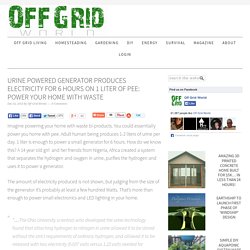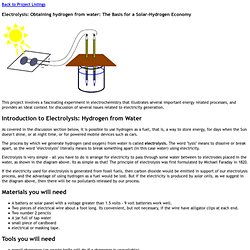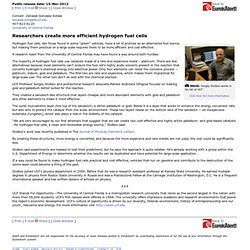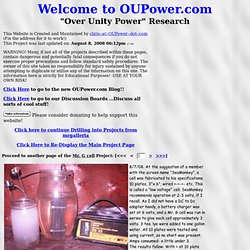

Urine Powered Generator Produces Electricity For 6 Hours on 1 Liter of Pee: Power Your Home With Waste. Imagine powering your home with waste bi-products.

You could essentially power you home with pee. Adult human being produces 1-2 liters of urine per day. 1 liter is enough to power a small generator for 6 hours. How do we know this? A 14 year old girl and her friends from Nigeria, Africa created a system that separates the hydrogen and oxygen in urine, purifies the hydrogen and uses it to power a generator. The amount of electricity produced is not shown, but judging from the size of the generator it’s probably at least a few hundred Watts. “…The Ohio University scientists who developed the urine technology found that attaching hydrogen to nitrogen in urine allowed it to be stored without the strict requirements of ordinary hydrogen, and allowed it to be released with less electricity (0.037 volts versus 1.23 volts needed for water)….”
Via: Solar power has gotten so good we can use it to power airplanes. An airplane has flown across the United States, powered only by sunlight.

The impressive feat was made possible by improvements in solar cell and battery technology. This chart, produced by the Department of Energy, shows how solar technology has improved: (Lawrence Kazmerski, National Renewable Energy Laboratory) The efficiency is the fraction of captured solar energy that is converted into electrical power. The Web site for the plane, named Solar Impulse, reports that the vessel was powered by monocrystalline silicon solar cells, represented by blue squares on the chart. Because the flight across the United States took more than 24 hours (specifically, about 2 months), the plane needed to collect energy during the day and then use it at night. Solar-powered airplanes won't replace traditional airplanes any time soon. Third-World Wind Power: First Look.
Electrolysis. Back to Project Listings Electrolysis: Obtaining hydrogen from water: The Basis for a Solar-Hydrogen Economy This project involves a fascinating experiment in electrochemistry that illustrates several important energy related processes, and provides an ideal context for discussion of several issues related to electricity generation.

Introduction to Electrolysis: Hydrogen from Water As covered in the discussion section below, it is possible to use hydrogen as a fuel, that is, a way to store energy, for days when the Sun doesn't shine, or at night time, or for powered mobile devices such as cars. The process by which we generate hydrogen (and oxygen) from water is called electrolysis. Electrolysis is very simple - all you have to do is arrange for electricity to pass through some water between to electrodes placed in the water, as shown in the diagram above. Materials you will need. Researchers create more efficient hydrogen fuel cells. Public release date: 15-Mar-2012 [ Print | E-mail Share ] [ Close Window ] Contact: Zenaida Gonzalez Kotalazenaida.kotala@ucf.edu 407-823-6120University of Central Florida Hydrogen fuel cells, like those found in some "green" vehicles, have a lot of promise as an alternative fuel source, but making them practical on a large scale requires them to be more efficient and cost effective.

A research team from the University of Central Florida may have found a way around both hurdles. The majority of hydrogen fuel cells use catalysts made of a rare and expensive metal – platinum. UCF Professor Sergey Stolbov and postdoctoral research associate Marisol Alcántara Ortigoza focused on making gold and palladium better suited for the reaction. They created a sandwich-like structure that layers cheaper and more abundant elements with gold and palladium and other elements to make it more effective. Mr. G cell Project Page 1. 8/7/08.

At the suggestion of a member with the screen name "SeaMonkey", a cell was fabricated to his specifications. 10 plates, 3"x 6", wired +-+-+- etc. Stan_meyer1.pdf (application/pdf Object) Edison Vs. Tesla. GravityLight. The edible battery that's too good for electric cars. Well maybe there's a good reason for that. The battery in question -- the aqueous sodium battery -- is actually too good for automotive applications!
It's so good, and has such an incredible lifespan, that the manufacturer is looking only to hard-core industrial uses for its first customers, like load-leveling for renewable energy systems. Not that that's a bad thing. But I'm ahead of my story. Our hero is Jay Whitacre , an engineering prof at Carnegie-Mellon U. in Pittsburgh. Solar goes Hyper in the U.S. As the U.S. government continues to heap billions in subsidies to the world's wealthiest coal and oil companies, the solar industry has been struggling to make it in the United States.

This is sad for many reasons, not the least of which is that we're missing out on one of the biggest growth industries in the world. Currently there are 16 gigawatts of installed solar power globally. That number will grow to about 1,800 gigawatts in the next 20 years, making it one of the best job creators. A Valuable Oversight.